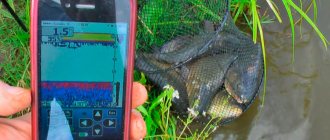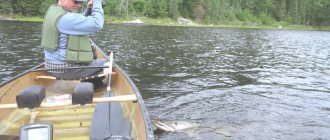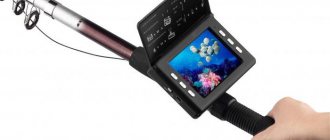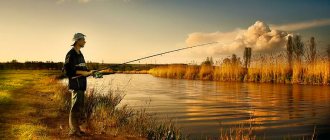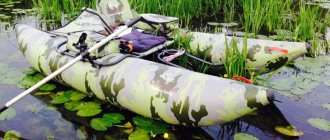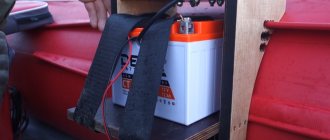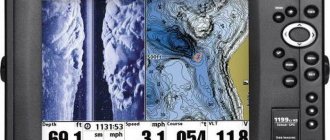Being a process filled with specific details and complexities, fishing requires from its fans not only knowledge, but also the necessary technical support. Below we will look at what an echo sounder is, the features of its use and the various options for the device.
With a penetrating eye, seeing where the largest number of fish swim is the dream of any fisherman. An echo sounder is just the device that allows you to do this.
It is required to perform the following functions:
- Determination of depth and bottom surface topography.
- Search for fish and their concentrations.
- Special features, depending on manufacturer.
The set should include two blocks. The first is a screen with a microcomputer that processes information, the second is a direct sensor that receives information.
In addition to such basic parameters that determine the class of an echo sounder, such as frequency and number of beams, the quality of the display is also important. The higher the resolution (the more dots that make up the image), the more accurate the data you will see.
Also, you should pay attention to batteries. Most likely, you will have to buy a power supply separately, as it is often not included in the package. Except for fairly expensive models.
The battery you can buy is small and not powerful. This device consumes little energy and can work at 4-7 ampere hours for about two days without any rest.
This device can be used either permanently, attached to a boat, or with a temporary mount. This device is not ultra-precise, so different models may have different results.
The fact is that the screen shows all the objects that are in the area of the beam, that is, all the snags, algae, etc.
How does it work?

The operation of this device is based on the interaction of elements such as a microphone, timer and loudspeaker. In modern models, the first and second parts are combined into one body for ease of use.
The sound source, that is, the loudspeaker, produces a beam of a certain diameter, directing it to the bottom of the reservoir. Reflecting, it returns to the device and is perceived by the microphone. The time during which the process occurs is recorded by a timer. Based on the fact that the speed of sound in water is 1440 meters per second, a calculation is made of where the bottom is and what obstacles are on the way to it.
For detailed calculations, a microcomputer is built into the case, which processes the data and displays the corresponding image on the screen. Its quality depends on the number of rays, their frequency and the resolution of the display itself.
The combination of loudspeaker and microphone is called a transducer. The basis of this device is a specific artificial crystal, which operates with energy. The diameter of the beam depends on the shape of this element. For the most part, crystals are installed in a cylindrical shape.
Which echo sounder to choose for fishing from a boat
The choice of echo sounder depends on what type of fishing the angler is interested in, the location of future fishing and his financial capabilities.
Before starting float, feeder, wire, plumb or ring fishing, the angler looks for a place in the reservoir with a concentration of fish. Having found an interesting hole or dump, he anchors the boat and begins to fish. For this method of fishing, it is enough to have an echo sounder showing the bottom topography and the presence of fish. These conditions are met by a device with a monochrome or color screen with a diagonal of 3-5 inches. For fishing from an anchored boat, a low-power two-beam transducer with a scanning depth of a reservoir of up to 50 - 100 meters is sufficient. To increase catches, it is desirable to have a Flasher mode in the echo sounder.
For spinning fishing using a motor boat or boat, you will need an echo sounder with a 5-7 inch screen with a fast processor and CHIRP and StructureScan sensors. A powerful echo sounder with sensitive sensors will help you detect a hole, a snag, a sunken tree, and will show on the screen a predator standing in ambush. The built-in GPS module will quickly lead you to catchy places of past fishing trips.
For trolling fishing, you need an echo sounder with a screen diagonal of 7-12 inches with a built-in GPS navigation module with mapping support and numerous side and bottom scanning sensors.
What is needed to set up the device?
To use your device most effectively, you must configure it correctly.
To do this you need to do the following:
- Don't be afraid to experiment, the factory settings are saved in memory.
- Determine and manually set the depth at which you intend to fish.
- We turn the sensitivity level to 75% and adjust it according to the current circumstances.
- If the screen is color, you can try to adjust this for maximum clarity.
- Configure additional parameters, such as noise reduction, image cleansing and other details that will allow you to project the image exactly in the desired area.
What is an echo sounder for fishing?
How it works
Echo sounders, also known as sonars, were developed around the forties of the last century to detect submarines.
The first sonars for sport fishing appeared in 1957. The main components of the device are:
- Transmitting device – generates a signal as electrical impulses and sends it to the sensor.
- Sensor – converts the received signal into sound emissions.
- Return signal receiver - picks up the signal reflected from underwater objects, in accordance with the time delay of the return of the sound wave, the distance to the reflection point is determined and, thus, a picture of the bottom topography and the location of moving objects (fish) is formed. The radiation is harmless and is not felt by living beings.
- Display – reflects a picture of the space invisible under water in real time.
Available Operations and Features
- Sensitivity. The function controls the product's ability to receive signals. If you need to consider the details, you need to gradually increase the level of sensitivity until the desired result is achieved. When the screen shows a lot of noise, you need to lower the sensitivity until you get clear reflections of the “fish arms”, if any are present. The sensitivity value can be changed both manually and when the automatic function of this function is turned on. The adjustment techniques in both modes are identical, but the resulting effects are different. Auto mode will allow you to increase sensitivity to the limit, but you can reduce it only to a level where the bottom topography differs. In manual mode, you can adjust the device to extreme values in both directions; you can distinguish the bottom topography from approximately the 50% sensitivity level.
- ASP function is a device that allows you to filter interference of various origins. It constantly analyzes the speed limit of the craft, light interference effects, and automatically filters signals of various types, eliminating interference. In sonar terms, any extraneous effects are called "noise." Noises can have a variety of origins, for example, the sound of a running engine or the operation of an ignition device. ASP has four operating mode settings: OFF – disabled, LOW – for low level, MEDIUM – for medium level interference, HIGH – for high level. If there is strong interference, it is better to use the HIGH mode, but the most effective way is to find the source of the interference and eliminate the cause of its occurrence.
- ALARM – warning signals. The design contains three types of such signals: “Fish” - FICH ALARM, triggered when the receiver identifies a set of signals as fish, the next signal (ZONE ALARM) is heard while moving to this place, and a depth warning signal, reacting when approaching shallows (Shallow), and also indicates the depth at the location. The warning is triggered only by a device for monitoring the bottom of the reservoir.
- CHART SPEED – setting the speed at which the display on the monitor is updated. Initially, this indicator is set to the maximum value. When the boat is stationary or drifting slowly, you can change the setting to 50%, this action improves image quality. When positioned in a stable position at maximum settings, passing fish will be indicated by long horizontal lines; as the scrolling speed decreases, these lines will become shorter.
- DEPT CURSOR – cursor indicating depth. Indicated on the display by a dash with numbers in the window. When moving it, you can obtain data about the depth of the object.
- FICH ID – fish identifier; the computer considers a certain set of reflections as a fish. At the same time, it distinguishes the size of fish as small, medium or large. Accordingly, a symbolic image of a fish of the appropriate size appears on the screen. It should be noted that a set of signals from any floating objects (branches, aquatic vegetation, water bubbles) can be interpreted as a fish. Where the sonar “detects” fish, there may not be any, and vice versa. Only the experience of a fisherman and an understanding of the basic laws of the underwater world can help here. And the echo sounder is only a fishing assistant.
- FichReveal – the mode selects from all signals only the one that identifies fish, using a “gray scale”. This means that weaker signals are indicated in white, and strong signals in black. There are about a dozen shades of gray in the gradation. When setting up the device, it is strongly recommended to turn off the automation and adjust the sensitivity to the maximum.
- GREENLINE – “gray stripe”. This setting allows you to distinguish weak signals from more intense ones. Thus, it is possible to distinguish a rocky bottom from a muddy one, which gives a blurred, indistinct outline of the bottom profile; a hard bottom looks like a clear, wide line.
Varieties
Garmin Multibeam Sonar
There are different types of echo sounder. It depends on the number of rays and their frequency. The higher the indicators, the more accurate the picture.
There are five types of devices, which are divided according to these indicators:
- Single-beam and the most common devices are inexpensive, suitable for small bodies of water. They have only one beam directed to the bottom and depth calculation simultaneously shows all passing objects.
- Double- beams have two beams, one of which is directed to the bottom and, accordingly, it determines the depth and topography of the bottom, and the second, less powerful, is emitted into the water column itself and searches for fish.
- Triple beams have three beams running in direct order, and due to this they have a relatively large coverage of the territory; this variety allows you to find out, among other things, the location of the object.
- Four-beam echo sounders have the same design as in the first version, only with the addition of another beam of smaller diameter in the central circle, which is intended not for studying the bottom, but for searching for fish in the water column.
- Multibeam echo sounders are the most expensive, but also the best option; containing about 11 beams, they can show a three-dimensional picture, which greatly simplifies the understanding of space under water.
You should choose an echo sounder not based on which one is better and shows more, but based on the subsequent purpose of the device.
For fishing from a boat, pay attention to the attachment of the echo sounder. Fastening methods can be of two types: transom and through. The transom is installed where the motor is attached to the boat. Through-mounting will require you to make holes. Choose a model with a mount that will satisfy your needs.
How the echo sounder works
Fishermen who are used to relying on their own skills may not understand what a fish finder is for. It is required when you need to quickly find fish, and the area of the reservoir is large. Setting up models is easy; image decoding does not require special knowledge.
If the factory settings are set to the correct mode, the device is able to show a clear picture. It’s better to immediately go to the pond and see how it works. You just need to turn it on on the spot, and then turn it off after fishing.
The echo sounder performs the following functions:
- Determining the distance to the bottom and its relief. With its help you can search for fish and their schools. Fishing with an echo sounder allows you to increase your fish catch.
- Depending on the manufacturer, the device may have other options.
The device consists of 2 blocks. The first is the screen. It has a microcomputer that processes incoming data. The second block is a sensor configured to perceive information.
In addition to such main characteristics as the operating frequency of the device and the number of rays, which determine the class of the device, when choosing, you should pay attention to the display and its quality. The higher the resolution of this node, the more accurate the data that the fisherman will see.
The scheme of work is as follows:
- The transmitter emits an electrical pulse. In the converter, it changes into a sound wave, which is transmitted into the water.
- When it reaches an object located in the water column or at the bottom, it is reflected. After this, it returns to the converter, where it is transformed into an electrical signal. It is amplified by the receiver and sent to the display.
- Sound travels at a constant speed in water, so the time interval between sending a signal and receiving the echo can be measured. This is how the distance to the object is determined.
- The echo sounder sends a wave several times per second, the incoming signal forms a picture that is constantly changing. The device will show not only fish, but also driftwood, accumulations of algae and other objects at the bottom or in the water column.
https://youtu.be/txzM_Ean98E
The devices operate with different wavelengths. Most often this is 192 kHz, but companies produce devices designed for 50 kHz. Although these frequencies belong to the sound range, they are not audible either to people or to the inhabitants of the depths. Therefore, fishermen can be sure that the operating modules do not scare the fish.
The device is used either permanently, attached to the boat, or with a temporary mount.
Its operation is not precise, so different models may provide different results.
Garmin Striker Plus 4CV Editor's Choice
The Garmin STRIKER PLUS 4CV fish finder has won many international awards. He received an award at CES 2021, won at the European fishing exhibition EFTEX 2021 and the Asian China Fish 2021 Deeper. The smart fish finder has been named an Editor's Choice by Fish Alaska, Anglers Mail and PC Magazine.

- For fishing at any time of the year and in any conditions.
- Creates a map of a body of water in the built-in Garmin Quickdraw Contours program.
- High accuracy of showing the depth of the reservoir and the location of the fish (its size, depth).
- Emits a beep when a fish is detected.
| Clear CHIRP ClearVü scanning sonar images. The STRIKER Plus 4cv fishfinder includes Garmin CHIRP technology that, when combined with Garmin ClearVü scanning sonar, provides nearly photographic images of what's beneath your boat. You will get a clear picture of underwater terrain, objects and fish. Traditional Garmin CHIRP sonar provides excellent target separation. Thus, this transducer will help you catch more fish. |
| Garmin Quickdraw Contours program. No one knows a body of water better than the one who fishes in it. While you cruise the shores and deep waters, Quickdraw Contours creates HD fishing maps for the areas you've visited. Users do not require special knowledge. The STRIKER Plus 4CV can store up to 2 million acres of Quickdraw Contours maps with 30cm contours. |
Buy on the official website with delivery. Price 5800 rub. There are seasonal discounts .
How to use the device most effectively?
There are two main options for using an echo sounder. You can use it from a boat or from the shore. Let's look at the features of each method in more detail.
Boat
In order for the echo sounder to transmit the necessary image to the screen from the boat, the following recommendations must be taken into account:
- If you attach it to the bottom, you need to place the converter on the floor of the boat and attach it so that there is no air layer in any case. You can glue it, or put it in a puddle of water - as you wish. During installation, do not forget to configure the device.
- If you are going to sail slowly, the device is mounted on the front of the boat; if you are going to swim quickly, it is better to install it at the back.
- In winter, the mounting method and echo sounder performance differ, which will be described below.
No need to worry, almost all echo sounders perfectly penetrate the thickness of the boat and influence the water column without adding any interference to the picture.
Shore
This option is less common, so it all depends on the device itself. Basically, this device is still attached to the boat. If you still decide to use it on the shore, you can, for example, throw an echo sounder specialized for this purpose into the water, and then catch the signal using your smartphone. Read a detailed review of the best coastal echo sounders.
Effective use of the device
Most often, the device is installed on a boat, but it is possible to operate the device when the user is on the shore. In all cases, the echo sounder must be adjusted depending on the fishing conditions. It is useful when fishing with a donk, but is also suitable for cases when the fish cannot be detected.
From the boat
When attached to the bottom, the transducer is placed on the floor of the vessel, making sure that there is no layer of air. If the boat speed is high, the device is installed at the rear.
From the shore
Most often, an echo sounder is mounted on a boat, but it can also be used on the shore. The device is placed in the water, thrown nearby, and then the signal is received on a smartphone.
When choosing a device in a store, you must immediately inform that it is required for fishing from the shore, then the required model will be provided.
Features of operation in winter
When going winter fishing, you should consider the following features of using an echo sounder during this period:
- It is worth protecting the device, and especially the battery, from the cold. For the latter, this is a disaster; for the device itself, temperatures down to -10 are quite accessible. In any case, it is better to build an insulated bag with your own hands, just a box lined with foam plastic.
- There are two methods for using an echo sounder: lower the sensor into a hole and freeze it in ice. Both are not ideal and can present additional difficulties, for example, making a holder for the transducer to place in the water or picking out the device each time to change the fishing location.
- Using the automatic fish recognition mode in winter is not effective.
- It will not be possible to determine the bottom topography , since the device is placed in one place, which does not allow studying a large surface.
Types of echo sounders
Currently, there is a wide selection of sonars on the market with different characteristics and prices. For convenience, they can be classified as follows:
- Echo sounders with a monochrome screen.
Relatively inexpensive devices with a simple monitor and a modest set of functions, which is quite enough to carry out the necessary measurements on a reservoir. In this case, there is a desire by the manufacturer to reduce the price of the product without sacrificing quality. - Echo sounders with color screen.
On a color monitor it is easier to read the bottom structure, detect fish among underwater vegetation, and understand what kind of object is within the sonar range. However, the small advantages hardly justify the high prices for devices in this class. - Echo sounders with touch screen.
Convenient, although expensive, devices. A simple, intuitive interface allows you to quickly make the necessary settings. - Echo sounders with GPS.
The advantages of devices with GPS are obvious. Especially on large bodies of water, where finding a favorite place can be very difficult. Some experienced fishermen use an echo sounder to first explore the bottom, record the coordinates of promising fishing areas, and even draw up maps. Choosing a fish finder with a navigation system is perhaps the smartest decision. - DSI scanners.
In echo sounders with DSI technology, the scanner beam is emitted in the form of a flat sector perpendicular to the movement of the boat, and not in a regular cone, as in classic models. Thanks to this, it is possible to obtain a higher quality image of the scanned area. - 3D sonars.
It's tempting, of course, to get a three-dimensional image of what's happening under the boat. However, due to a number of shortcomings (small screen, inaccuracies in displaying objects and bottom topography, high price), this class is not in particular demand. - Portable wireless echo sounders.
The float sensor is tied to the spinning rod, thrown into the desired place and smoothly pulled towards the shore (boat). According to the fishermen who tested such an echo sounder, it will help you choose a suitable place, but it doesn’t show fish well. Imagine how effective a sensor dangling on a wave would be. - Forward looking echo sounders.
Sonars of the classic type, collecting information on the course of movement of the craft. Little popular among amateur fishermen due to the high cost, complexity of adjustments and analysis of the data obtained.
How to understand information on the screen
You need to understand the picture on the screen based on how many rays your device has.
If there is one, then the image will be flat and all snags, fish and other objects in smooth motion will be shown as a straight line. If, for example, the fish is swimming upward towards the bait, the picture will show you an arc.
A two-beam one will show the bottom more clearly, a three-beam one will demonstrate, among other things, its place in space. A multibeam echo sounder displays a three-dimensional image that is much easier to understand.
There is also an automatic fish recognition mode, however, it is not reliable. Here, as a future catch, the device may receive interference in the water or some kind of rubbish.
A few final tips

Pay attention to such details, invisible at first glance, that at the decisive moment can ruin all the fun:
- The echo sounder battery runs out much faster in winter ; if you plan to fish for more than a day, take a spare one or, if you have a car, an appropriate charger.
- The best and highest quality echo sounder is not always good, and to be precise, it is often pointless. If you are going to use the device in a local lake three meters deep, a four-beam device will be superfluous; a cheaper single-beam device will be enough for you, which will show all the necessary information
- When reading information from the echo sounder screen , be prepared for the fact that it is mistaken and it is actually not one big fish, but a flock of small ones or even a shoe. This can especially happen in automatic mode. If you want more accurate results, learn how to perform the analysis yourself.
Use the device in accordance with all the listed rules, and it will really brighten up and make fishing easier, will not spoil your nerves and will ensure a rich catch.
What does the echo sounder show?
Now let's try to understand what we see on the screen from what the echo sounder found underwater? If the boat is moving, then the sensor after a certain time interval (fractions of a second, and this interval can be changed in the echo sounder menu), as if photographing the bottom and the fish if it falls into the signal beam. This rightmost point always displays events in real time! When the current photo is replaced by a new one, it simply moves to the left and nothing else happens to it. He has already become history. The fish that was there may in fact have already swum away and be in a completely different place. It may also even fall into the field of view of the side beam (this happens), but on the echo sounder screen its image will remain unchanged at the same depth, and will slowly move to the left until it disappears from the screen.
In the same way, the displayed bottom relief will characterize the area that the boat sailed during the time until the “bottom snapshot” moved from the rightmost point to the leftmost point of the screen. Usually this is intuitively clear to everyone at once. However, if you have marked for yourself the edge that you are going to fish, then in order to move from it to the desired place where you need to anchor, you need to have a very good idea of how far you actually need to swim so that it corresponds to the picture changing on the echo sounder. It is not so easy to accurately correlate your movements on real water with the diagrams presented on the screen.
The fish finder continues to draw the bottom even when you are already at anchor. In this case, a straight line will appear on the screen, but due to the waves, irregularities may appear on the bottom! And the fish finder will clone the fish under you if it stands still. Likewise, the distorted terrain will be presented on the screen when you swim closer to the shore and then move away from it again: a characteristic section of a hill with ascent and descent will appear on the screen. On the screen, the echo sounder will simply add your forward movement to your backward movement, and from the picture it will be unclear that this is the same section of the bottom: you just weren’t swimming straight, but spinning in place.
If you approach the edge at a right angle, it will seem steep; when you do it faster, the steepness will increase even more. And if you approach the same edge at an acute angle, the steepness of the slope will decrease significantly, and you will not pay due attention to it. An echo sounder can generally draw a flat bottom for you if you move along the edge, even while in the middle of it!
Options for reflecting the same section of the bottom when moving in different directions
The picture shows a drop into the riverbed, where the steepest edge is located between 5 and 8 meters. The green trajectory (A) shows the boat moving at an acute angle to this drop, and on the echo sounder screen its steepness does not seem so obvious. Moving along the red route (C), the edge looks like a real cliff. The yellow trajectory (B) shows a boat in which the angler, having reached the edge, began to look for an anchor and was carried back. As a result, the echo sounder drew a hill.
To get a more or less accurate idea of the area of the bottom you are interested in, you need to swim over this area at least several times in different directions, compare the information received, and come up with the missing elements. It is not simple. I have been regularly torturing my echo sounder for more than 10 years, and still, in order to anchor correctly and the first time, I mark critical points with a kind of mark - for example, I place an empty boss in the center of the channel, which serves as a guide buoy for me, from which it is easier visually measure the effective casting distance. Believe me, when you are blown away by the wind and wave, it is very difficult to understand without external reference points how far you are from a given point, 20 or 50 meters?
In addition to the bottom topography and depth, a very important clue for the fisherman is information about the hardness of the bottom and the presence of various near-bottom objects. For example, it is obvious that looking for pike perch where the bottom is covered with a thick layer of silt is not very promising. And various bottom objects may turn out to be flooded with stumps, boulders, snags, and ultimately serve as suitable shelters for predator ambushes. This is a very strong argument in favor of echo sounders, the display of which can provide a well-detailed picture, even if it is conditionally true. Such a picture instills confidence in the fisherman, and confidence stimulates perseverance and more decisive actions, and therefore a greater likelihood of a good catch.
Now about the fish. Is it difficult to understand from the echo sounder readings what kind of fish is underneath you? Is it pike or bream? A school of bream or a hungry perch? Therefore, none of the echo sounder manufacturers, to date, makes any distinction in fish pictograms between pike and bream. But we have a rough idea of the size of the fish, the depth at which it is located, and if the echo sounder allows, then on which side of the boat (or even straight ahead) this fish is swimming.
We can only guess and make assumptions, based on our ideas about the life of fish, who is underneath us. Let’s assume that there is a large fish hiding under a boulder or stump, most likely a pike, but maybe a pike perch, and a school of small fish above them is a roach. Maybe so, or maybe quite the opposite - a carp or bream is hiding in the shelter, and a school of perch is frolicking above. It can be interpreted in different ways. It is more important to the angler at what depth the fish are mainly located. And the information about what depth the fish stays at is far from unambiguous, and rather offers us options for analysis. For example, one summer the echo sounder persistently showed that all the fish were at the surface, and only here and there at the very bottom, almost 10-11 meters, were rare single individuals found. I bet on the latter, and I was not mistaken. I launched the mugs along the very bottom and caught three good pike perch on them, while from 3 meters there was not a single bite.
In addition to the popular combination of an echo sounder with a navigator today, useful additional options may also be the function of simple speed measurement (without GPS) and the ability to measure water temperature. For many models, the water temperature sensor is combined with the main sensor; for some, such a sensor can be connected and installed in the echo sounder, but it must be purchased separately.
Many echo sounders are capable of displaying what is called a raw signal. Experienced fishermen consider it more important than a fake display of fish symbols. With this interpretation, the fish on the screen is represented as an arc. In fact, such arcs consist of a sequence of individual “snapshots” of the reflection of the beam from an obstacle that has arisen, as either the object changes its position within the beam cone, or the beam passes over the object.
Let's imagine that we are slowly swimming over a fish standing below us. We haven't reached it yet, but it hits the very edge of the beam. The return signal from it is still weaker, and the fish is currently further away from us than when it is directly under the boat. In the center of the beam, the signal becomes stronger, and the fish is reflected fatter, and the distance to it becomes shorter. As the beam exits, the picture changes in the reverse order. As a result, a series of such photographs turns into an image resembling an arc, with a thickening in the center.
The size of the fish can be judged by the size of the largest thickening in the center of the arc, and comparing it with the arcs of other fish located at the same depth.
What else can the arc tell us? If the arc is short, then the fish moves towards us and passes the cone of the beam faster. A long arc indicates that the fish is following the boat and remains in the beam cone for a long time. In the case when the boat is anchored, a long arc, and often a straight line, indicates to us that the fish has been standing directly under the boat for a long time, and a short one - that it is swimming under us.
If the left edge of the arc is thicker and lifted up, and the right one becomes thinner and goes down, then this means that the fish, when approaching the boat, went to depth. If, on the contrary, the left edge is lower, then this means that the fish was moving upward. Learning to read arcs is not difficult, but for this, the echo sounder display must again have good resolution so that the arcs can be seen clearly, otherwise it is difficult to understand them.
In practice, by analyzing various arcs, it is possible to identify such details as the attack of one fish on another. I tried to display the geometry of the arcs and the attack on the diagram as far as possible.
Displaying fish with arcs
The picture is as follows: The boat is standing still. The pike moves straight (red line). The roach, when the pike swims up to it, gets scared and also goes straight up (blue line). Both fish enter the echo sounder sensor beam zone at the same time and leave it at the same time. Point A, where the fish fall into the field of view of the beam, will be to the left on the echo sounder screen. This is older information than the output from the beam cone. The shape of the blue arc indicates that at the beginning (point A) the fish was deeper, and at the exit (point B) it rose closer to the surface. Closer to the center of the beam, the signal is clearer, so the line that displays it is thicker.
